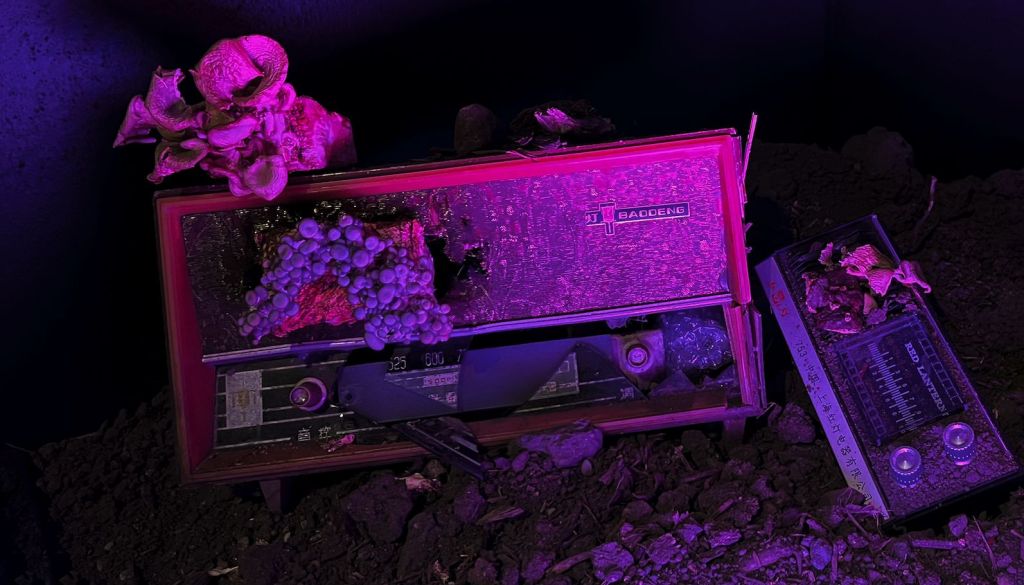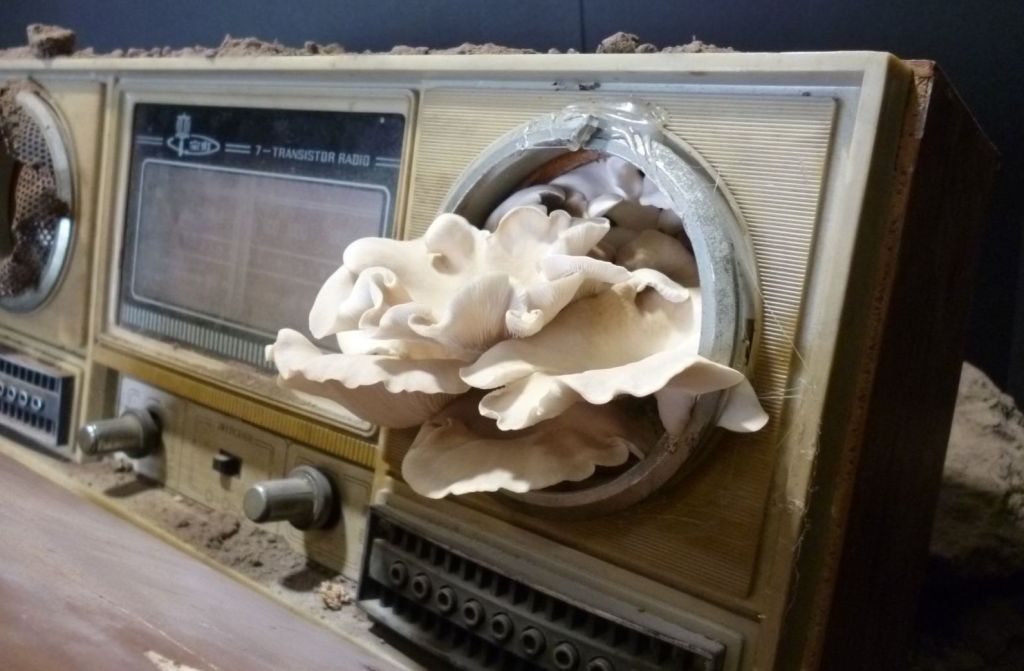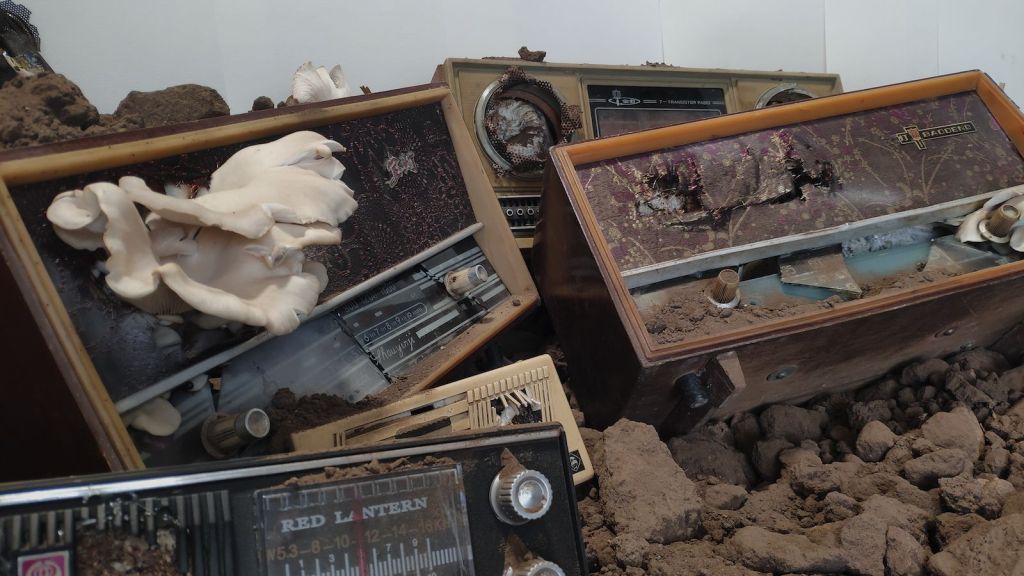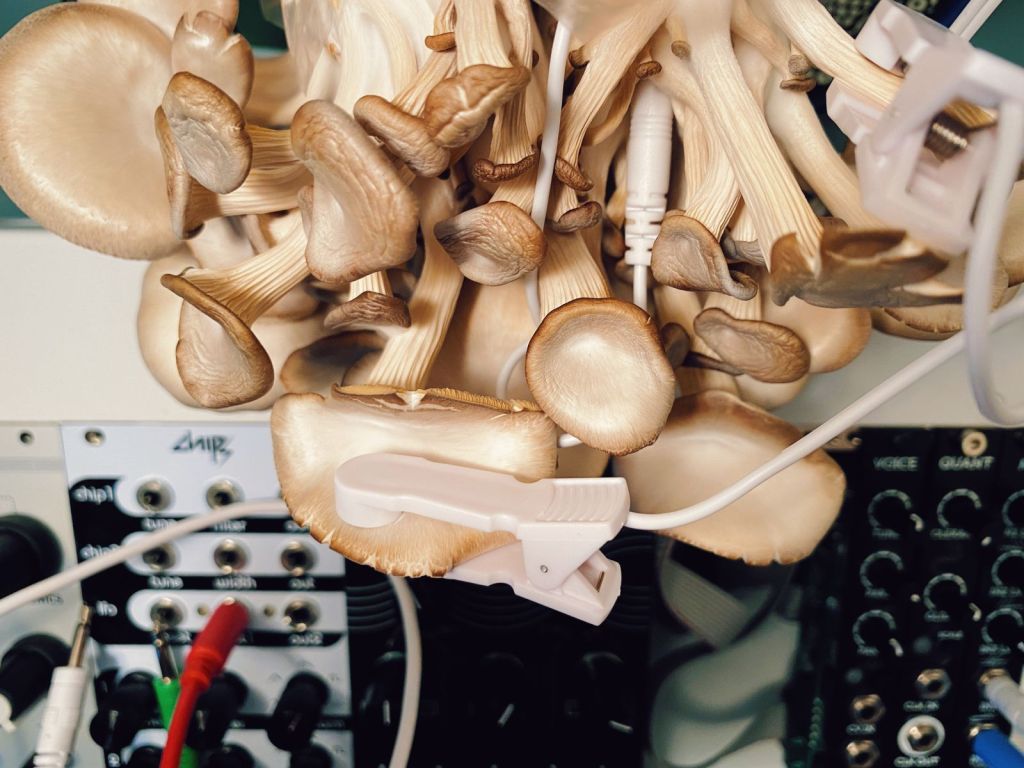Interview by Piotr Bockowski

Eryk Salvaggio’s most recent album release, Worlding, involves fungi manipulating the knobs of a specially designed synthesiser that intercepts fungal nervous system signals and translates them into electronic sounds via cables plugged into mycelium. This maverick performance of bio-hacking follows Eryk’s previous experiments with AI-assisted art, and at the same time, it recognises mediations of fungi as a more sophisticated approach to technology and sentience than criticised by him as “technocratic AI obsessions”.
At the beginning of the dystopian Australian covid lockdown in 2020, Eryk was isolated in a studio across the street from the largest supercomputer in the Southern Hemisphere, where he created a ‘music band’ together with AI – in an act that he recognises now as a desperate attempt to fight against human loneliness within the technologically controlled world. He put into practice his studies of Applied Cybernetics in order to create ‘underground pop music’ with artificial intelligence. The AI-generated some lyrics trained on cybernetics, situationist and feminist texts, as well as produced samples for tracks based on GPS tracking of animal movements. Engendered by Vocaloid voice synthesiser, the Organising Committee project of Eryk’s “cyborg pop” incorporated a heavy mix of analogue recorded and digitally produced sounds.
Calculated as a push of ideologies of computation ‘beyond the binary’, artificial intelligence music-making fed by data coming from technological surveillance of organic life only inspired Eryk’s electronic sound experiments to engage more uncompromisingly with the alien intelligence of nonhuman biology. Eventually, Eryk found a sense of meaningful kinship with fungal companions of the human species.
Worlding invites listeners to communicate with fungi as the most vital media and superior nonhuman intelligence within what Eryk calls the ‘cybernetic forest‘, which comprises of ‘data-animated’ digital processes in intimate conjunction with organic continuity of analogue processes. Both types of processes are combined in a vitalist understanding of database technologies, which contextualise machinic computations through participation in the living biosphere.
Being a researcher of new media between several USA universities, Eryk facilitates workshops addressing life-affirming cultural processes, such as new technologies for grieving the dead or immersive media storytelling. He also teaches AI image generation, game design, as well as the history of the World Wide Web, amongst other cutting-edge subjects.



Right: TENS cables and clips of various kinds carry electrical communication spikes from an Oyster mushroom to a modular synthesizer to record “Worlding: Sympoietic Mycology.” Photo credit: Eryk Salvaggio
In your compositional process, you’ve involved fungi as co-creators of sounds. What exactly is the technical role of nonhuman biology in your electronic music-making?
Worlding was a way of exploring relationships between living and non-living things, with humans in the position of listening rather than controlling. So for most of the record, the mushroom is responsible for the knobs. As the mushroom responds to changes in its world, it sends messages through subtle voltage spikes within its body. These spikes inform other parts of the body/network about what’s going on. We can intercept those signals and direct the voltage into a modular synthesizer. I used TENS cables, which are designed to send electrical pulses to muscle tissue. But here, the mushroom is the source of the pulse, not the recipient. The cables carry those pulses into the synth to create rhythm changes or tonal shifts.
I might spray the mushroom with some mist or turn on a lamp overhead. In one case, I simply rested my hand on it. But the concept of the project was for me to get out of the way.
What is the significance of fungi research by Science Detroit Gallery and Xi’an Jiaotong -Liverpool University for your art?
The album is a series of test recordings. They were created while building this synthesizer-mushroom setup for an installation at the Michigan State University’s Science Museum and CoLaboratory, for an exhibition called 1.5° Celsius. The project is an installation there, with one of these mushroom patches activating music in response to the environment in the museum.
The physical structures for that project were created by Claudia Westermann and Vinny Montag at Xi’an Jiaotong-Liverpool University, wherein the mushrooms emerge from a landscape of broken radios and soil. The installation presents death and birth at once. It’s an emotional landscape, generating electronic sounds controlled by organic growth amidst human debris.
Together with Hao Liu, a graduate research student at XJLU, we’re looking at the varieties of mushrooms which can metabolize, remediate, or engage their surroundings in ways that can become conduits for further compositions. It’s an ongoing art/science design research project, and we’ll be creating strategies for workshops, installations, and home kits for creative mushroom cultivation.
We’re still keen, for example, to make a fungal CD player which can dissolve layers of plastic, metabolize it, and “play” the CD’s material decomposition through the synthesizer. Of course, it’s not going to play the digital data encoded on the CD, but I like it better that way. We want to have it break down a copy of Guns and Roses “Appetite for Destruction” because destruction is literally what a mushroom eats. It transforms destruction into sustenance and growth. Mushrooms metabolize debris, including cultural debris, and transform it into something generative. They can absorb crude oil and still be edible. There’s a lot of hope in these things.
The title of your album Worlding references a concept of multi-species symbiotic worldmaking, which provides a framework for trans-human civilisation projects. What is your ecopolitical worldview?
Mushrooms are a networked being. They did it first. The local area is always macrocosmic for them. I keep trying to think like a mushroom, to understand my body as embedded into a network of kinship and reciprocity. So how do we listen? How could we, for example, give mushrooms agency to participate in governance decisions? Well, a synthesizer is a simple computer. While making the album, the mushroom became very present for me. It tells me that we could design technology to make these worlds more discernible, not less. That’s a start in making ourselves more accountable to natural systems.
I think of this work as a human-decentered design. I’m sure that’s someone else’s term, so I don’t mean whatever they mean. I don’t have a big theory about it. It’s just literally: decenter the human first, then design. But human decentered design is a constant failure because we cannot escape ourselves. Our humanness is always going to come through. But if our humanness is going to come through anyway, why centre it? Decenter it and see what else you can make space for.
How do you understand A. Adamatzky’s claim about the existence of “fungal language”, complete with half a hundred “words” vocabulary arranged in repeatable patterns?
I’ve never spoken with Dr Adamatzky. I’ve just read his papers, so fungal language seemed very abstract until I finally heard it. I’d left an old, hot office lamp running near the mushrooms, which began to trigger the synthesizer quite aggressively. I recorded it, and the next day I tried it again. I made three recordings. The mushrooms began these aggressive spikes two minutes after turning the lamp on and stopped seven minutes after I’d turned it off. The threat had passed. Just before they stopped, they played a near-identical pattern: a series of spikes in a row at the same time interval. Looking at the image data from the recording, there was a near-perfect overlap.
This was revelatory to me. Was I hearing mushrooms complaining about the lamp? I’m kidding, but only sort of. I’m careful not to say that I know what the spikes were. They could be language or an inadvertent biological response, like the signal telling a Venus Flytrap to close when a fly lands on it.
I am not sure that it matters. It was information being transmitted through media by a being that most people would not identify as responsive or aware. There is still debate about how “sentient” a mushroom is, which is more of a cultural boundary than a word with a precise universal definition. Crucially, the mushroom had created music.
In some of your previous projects, you worked with AI. What are the differences or similarities between making music with fungi and AI?
There’s this idea of the cybernetic circuit, which begins with something on a screen, or in your ears — any kind of computer-produced output that you can look at and respond to. That changes what you see on the screen. Think of video games or interactive music. You are co-creating an imaginary space with the computer. You’re projecting yourself into the screen or the soundscape, responding and being responded to, and living in this imagined, co-created world. It’s an augmentation of the imagination, this cybernetic circuit. In that imagination, it becomes very seductive to look for something responding to us. So, we project intelligence into databases and statistical analytics. We call this artificial intelligence, but it exists mostly in this imaginary space created by the illusion of exchange.
When I make music as The Organizing Committee, I’m creating lyrics from AI-generated texts, trained on the books I read: cybernetics, situationist, critical & feminist theory, STS… I must guard against taking that output seriously as “thought”. If there is thought, it’s because I’ve done the work of reassembling them in meaningful ways as song lyrics. But I make the meaning. Machines are definitely political, but they can’t write manifestos.
With “Worlding,” on the other hand, there’s something else going on because a mushroom is not the product of some tech company deciding which statistical correlations can write blog posts more convincingly. The cybernetic circuit is there, but the machine is not overpowering the mushroom. Instead, the mushroom and synthesizer are, I like to say, entangled. We’re listening in as the mushroom responds to these wires, and the wires transmit that exchange through our speakers. We can get lost in a different kind of cybernetic circuit, one more focused on organic kinship than technological mediation. I may be naive, but I think Worlding reflects a more hopeful approach to computing than our current obsession with artificial intelligence.
So many people are desperate for artificial intelligence systems to be sentient. I think it’s because we’re lonely. The rich, technocratic states that drive AI research have been extracting themselves from any kind of entanglement with actual sentient things, aside from the small handful of creatures that sleep on our couches. This distance from entanglement would make us ache for company. I think we’ve become damaged by this self-imposed exile, and lost the language to express that lack. Now the desire is not even for sentient companionship, but sentience reintroduced into controlled, isolating technospheres. We are longing for Worlding. We want to be enmeshed and intertwined with that mushroom pulse. But we are so distant that we don’t know where to find it. In the lack, we project new desires onto the tools we control. We want to make-with, and so we invent an imaginary friend: the “sentient” Artificial Intelligence system.
Sound impressions in most of the nine tracks from your fungal album rewind me to retro SF film soundtracks I’ve always enjoyed- are there any cinematographic visions that inspired “Worlding”?
Not specifically, but a film that serves as a vision for so much of my work is Godard’s Alphaville. It’s a world where artificial intelligence has cut humans out of the circuit altogether. Humans respond to the machines, but the machines don’t respond to people. So while Worlding is not exactly a “soundtrack” for Alphaville, it’s a response to the timely concerns of that film — that humans would be in thrall to probabilities. Worlding takes a different view, one from the often neglected second wave of cybernetics, where Stafford Beer and others were keen to create spaces that accommodated a variety of behaviours rather than constraining behaviour to narrow patterns of interfaces. That’s the structure that served as the model for this record. It’s a mushroom operating within a designed system rather than a series of deliberate musical compositions.
Are you planning to involve trans-species collaborators in your future projects?
I would like to continue exploring the sonic interiorities of mushrooms. I have a dream of bringing a solar-powered synthesizer with me to various forests, plugging my TENS cables into the local mycelial networks, and recording music from the trees. Perhaps touring that way: we go into a forest and find mushrooms and listen to them. I’ll need to grow my beard three feet longer, maybe.
I’m also interested in ways we might expand “worlding” projects to include human responses, possibly with brain-computer interfaces measuring biological responses to mushroom-generated music. Those responses could trigger new complications in response, reconciled by the synthesizer. A true human-mushroom-machine entanglement. There are many questions raised about how we could design tools for these trans-species collaborations. Music is such a nice way to test and explore these concepts. Nobody gets run over by a self-driving cybernetic mushroom synthesizer, you know?
What is more important: to take or not to take yourself too seriously in order to be creative?
I think George Saunders has this writing prompt, where you take the premise of a well-known joke, and you stay in that premise until it becomes a whole world. That’s how I approach creativity. I take the work seriously, but I also see some humour in how seriously I take the work. You have to see the work from multiple angles, and one of those angles is always going to be the proposition that your endeavour is kind of ridiculous. If you can really see your work from that position, it helps. In my head, I’m thinking about, like, “decentering anthropocentrism in design,” but to most people, I am a weird mushroom guy. I think a lot of my work takes that posture of, you know, “oh, this is kind of silly, but let’s hang out and see how it ends.”
One for the road… What are you unafraid of?
Wild mushrooms! They are a risky culinary proposition, but we foraged wild Shaggy Mane mushrooms and ate them recently, and I’m still here!






